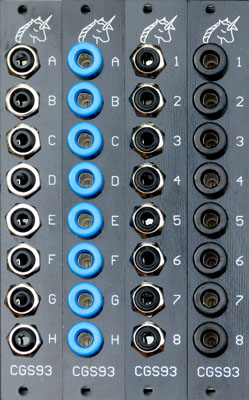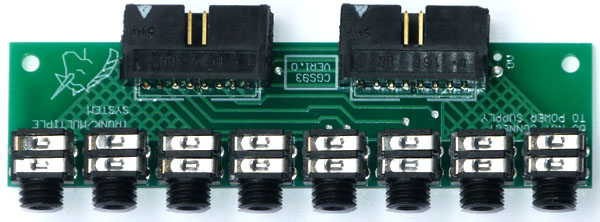
These boards can be used as cascadable multiples, to create trunk lines between different cabinets, or assuming you have something else that uses the same termination, for expansion/breakout. It uses 16 way ribbon, like used in EuroRack power, every second wire connected to ground to form a shield between the signal wires. You can mount one of these in each cabinet of a large system, and hook them up from behind with the ribbon.
As a bonus, the board is designed to work with banana jacks as well, so your bus/trunk lines can go between different types of synths (mini jacks and bananas). 
Pad identification:
ConstructionBefore you start assembly, check the board for etching faults. Look for any shorts between tracks, or open circuits due to over etching. Take this opportunity to sand the edges of the board if needed, removing any splinters or rough edges. Jack centers are at 1/2" spacing. The board will fit behind Euro and Frac rack panels.
As banana jacks have no earth connection, one has been provided on the PCB itself for when you install banana jacks. Hook this to the nearest convenient power supply 0V/GND point on your panel. This will ensure the shield wires in the ribbon cable(s) are earthed. The panel has two sides, one labeled 1-8 the other A-H.

To use the boards as multiples, several need to be mounted side by side, and linked with a cable such as the one shown above, or using short, two-plug cables alternating between the top and bottom sockets. In this configuration, the multiples will be horizontal. While the extra expense of doing this way may not seem logical, consider if you were to interleave these modules with others in your system, or if you were to have one on each row in a cabinet. It can then be used as a distribution bus, rather than just a multiple. Using just two of these modules situated in different cabinets, with a ribbon cable between them creates eight trunk lines. That allows you to use short patch cables within a cabinet, and the trunk line to ferry any signals to the other cabinet where, again, short cables can be used for patching. This eliminates the need for long cables to be strung between cabinets, where invariably they get in the way.

Both of these methods of interconnection are valid. Parts listArticle, art & design copyright 2013 by Ken Stone |

